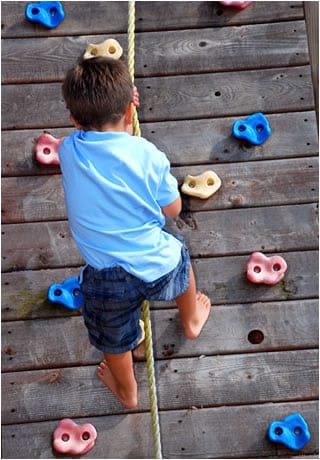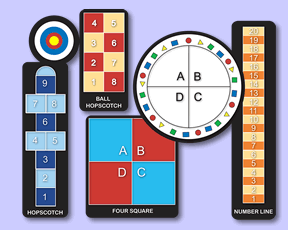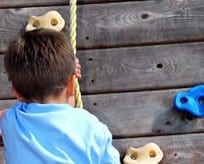Sounds like a tiny tot gym for aspiring World Body Builders like California Governor Arnold Schwarzenegger, but instead it is a new federal program aimed at giving preschoolers a head start on future healthy behaviors and generally good health.
The new center called the National Center for Physical Development and Outdoor Play AKA Head Start Body Start![]() , received a $12 million, four-year grant from the US Department of Health and Human Services federal administration for Children and Families.
, received a $12 million, four-year grant from the US Department of Health and Human Services federal administration for Children and Families.
The National Association of Sport and Physical Education![]() (NASPE) secured the grant after a competitive process. NASPE is known for their ability to mobilize and service children across the nation in advocacy for physical education, physical activity, and nutrition.
(NASPE) secured the grant after a competitive process. NASPE is known for their ability to mobilize and service children across the nation in advocacy for physical education, physical activity, and nutrition.
AAPAR executive Director Mariah Burton Nelson added, “Through this partnership, almost a million children will receive not only a head start but a body start, not only academic preparation but physical preparation.”
Head Start Preschools across the nation will be competing for sub-grants for construction or improvement of playgrounds and outdoor play spaces at Head Start Centers![]() .
.
Competitive Head Start Body Start competitive grants will be released later this spring for improving Head Start Center playgrounds, as well as increasing physical activity.
The grant couldn’t come at a more opportune time.
Making the case for outdoor play.
A study by researchers at Cincinnati Children’s Hospital Medical Center points out the importance of educating not only children but adults on the importance of outdoor play. The study found that “Some workers said the outdoor play is too much trouble because it requires time to bundle up kids during the cold weather.” Another challenge identified by researchers is called the flip-flop factor. Day care workers keep children inside if they show up in flip flops rather than sneakers on a chilly day.
Read More at The Recess Blog – Why Children Spend So Little Time Outside.
Preschoolers mostly inactive in play.
It sounds like an oxymoron. How can one be inactive at play? But two studies recently released attest to that fact. The first study can be found in the January/February issue of Child Development Magazine, which found that preschoolers were determined to be in the moderate-to-vigorously active category at play only 54% of the time while engaged in outdoor activities. More alarming was the finding that preschoolers were sedentary 94% of the time when indoors. Put simply, preschoolers are inactive even in play.
As a result of their findings, the researchers recommended that future interventions designed to improve physical activity levels among preschool children should focus on increasing the availability of outdoor materials and ensuring sufficient open space for recreation. The researchers also recommended that teachers organize, model and encourage physical activity among students.
The second study conducted at the University of South Carolina arrived at similar conclusions. They looked at 3, 4 and 5-year-olds in preschool and found that they were “anything but physically active”, even when playing outdoors.
According to the study, of 539 children in 24 preschools, 89% of the children’s day was characterized as sedentary. Even when the children played outside, 56% of the activity was sedentary, 27% was light physical activity and only 17% was moderate-to-vigorous physical activity.
In the study, the teachers rarely encouraged the children to be more active, said the lead author of the study, Russell Pate, of the University of South Carolina. Read more about this study in the Los Angeles Times article entitled, “U.S. preschoolers are not busy little bees“![]() .
.
Children today are missing out on something essential. Play!
Stuart Brown created the National Institute for Play in 1996 after more than 20 years of psychiatric practice and research persuaded him of the dangerous long-term consequences of play deprivation.
According to Brown, “If you look at what produces learning and memory and well-being, play is as fundamental as any other aspect of life, including sleep and dreams.” Play (or lack of) is the one thing that most educators, parents, and psychologists agree on. Public health officials link insufficient playtime to a rise in childhood obesity.
Learn More in our Featured Article – Low cost, high activity playgrounds.
Creating a better playground.
Simple playthings such as balls, jump ropes, hula hoops and riding toys do more for encouraging physical activity than swings, jungle gyms and other stationary playground equipment, according to a recent report in the “American Journal of Preventive Medicine”.
The American Journal’s findings are important because they show that schools and day-care centers do not need expensive playground equipment to keep kids active.
The data was collected by researchers from the University of North Carolina School of Public Health from 20 childcare centers across North Carolina. The goal of the researchers was to determine the various environmental factors that encourage children to play with greater intensity and for longer periods of time.
Head Start Body Start Play Space Grant Information
- Available to Head Start grantees through an annual Request for Proposals.
- Up to $5,000 for the playground and outdoor play space improvements.
- 400 sub-grants in year 1 (by September 30, 2009).
- Approximately 380 sub-grants per year in years 2, 3 and 4.
Head Start Body Start grants from the National Center for Physical Development and Outdoor Play will be released later this spring.
To find out more about how your Head Start Center can apply for these grants, sign up for the Head Start Body Start e-newsletter or visit the HSBS National Center website at www.headstartbodystart.org![]() .
.


